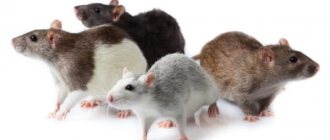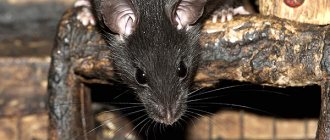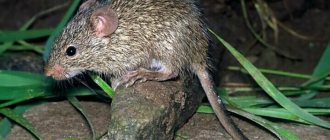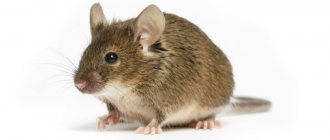Rats are the most common members of the mouse family on the planet. More than 60 species of rodents belonging to this genus live on Earth.
The life of rats is closely connected with humans. And if only for this reason, it is worth learning more about these truly unique animals.
Description and characteristics of the rat
Rats are mammals belonging to the order of rodents, the mouse family. You can meet representatives of the genus in all corners of the planet. Most varieties are synanthropic, that is, they exist close to humans.
Appearance
Regardless of species, it is quite easy to recognize a rat. The animals have a dense, elongated body, a round head with an elongated pointed muzzle, powerful paws with mobile, very dexterous fingers, between which membranes are clearly visible, and a long tail. Tenacious fingers allow rodents to deftly climb trees, and membranes allow them to swim. The tail of most species is bald, covered with scales and sparse hairs. The length of the tail can be either less or longer than the length of the body. Thick, rather hard fur grows throughout the rodent's body. The color is most often grayish-brown or dark brown interspersed with red or yellowish hues.
Appearance
The rat has small ears, small eyes, and whiskers on its head. The jaw has incisors that are significantly larger in size than the rest of the teeth. Rats' incisors grow throughout their lives. Animals must constantly chew hard materials to wear down their incisors, otherwise over time they simply will not be able to close their mouths.
Rats' vision is quite poor. Rats have difficulty distinguishing colors, relying mainly on their senses of smell, touch and hearing. But thanks to the ability to perceive the slightest changes in brightness, rats see perfectly in the dark. This partly explains the increased activity of animals at night. Because the eyes are located on the sides of the head, the rat's vision is panoramic, meaning each eye perceives a separate picture.
The weight of an adult rat, depending on the species, varies from 40 to 500 g, and the body length (without tail) from 9 to 30 cm.
Sexual dimorphism
Sexual dimorphism in rats is not as pronounced as in some other animals, but it is still not so difficult to distinguish a female from a male. The main feature is, of course, the presence of rather large testicles in the male, which are located under the tail and are clearly visible. Besides:
- males are larger and have a more powerful build;
- The body shape of the female is more elongated and slender, while that of the male is pear-shaped;
- The fur of males is tougher and denser;
- females have 2 rows of nipples on their abdomen, males do not have them;
- The distance between the urethra and the anus is greater in males than in females.
All these differences become clearly visible as the rodent grows, but it is almost impossible to determine the sex of a recently born rat pup until a certain point.
Functions of the tail in rats
The rat's tail is a very important part of the body; if it is lost or damaged, the animal becomes vulnerable and helpless. So, why does a rat need a long tail:
- helps maintain balance (with its tail the rodent can cling to a support, can lean on it while standing on its hind legs, or control balance while moving on a shaky structure);
- supports thermoregulation (there are many blood vessels in the tail that can expand when the animal is hot, or contract when it is cold, thus the blood slightly cools or warms up, which means the rodent’s body temperature drops or rises).
Ponytails
The answer to the question of why rats have bald tails is very simple. Since in nature rodents live near bodies of water and also constantly move in burrows underground, the shaggy tail would collect dirt, preventing the owner from moving quickly.
Examples[edit]
Mythology and folklore[edit]
- The Indian god of wisdom Ganesha rode a rat.
| « | There is a rat and a hamster. The first one is all thin and sad, and the second one is fat and happy. The Rat asks the Hamster: “Why does everyone love you, keep you at home, feed you delicious food, although we are both rodents?” We differ only in the length of the tail and the color of the coat! The hamster answers: “It’s not the length of the tail or the fur.” The main thing is to choose a smart image maker! | » |
| — Anecdote | ||
- The rat/mouse is a symbol of the first year in the 12-year cycle of the eastern calendar. The cunning creature arrived on a bull and at the last moment jumped forward.
- Psychologists joke that they know a lot about sophomores and white rats and very little about everything else. Because experiments are most often carried out on these two groups.
Theater[edit]
- Tchaikovsky's ballet "The Nutcracker" in the variation to which Mikhail Shemyakin had a hand. Here the rodents are typical evil clowns from the Venetian carnival, and also slightly dressed up as Prussia.
- -//- “Sleeping Beauty” - the evil fairy Carabosse rides around on a cart pulled by rats.
Literature[edit]
- Rats terrorizing the peaceful townspeople of Gammeln in all versions of the story of the Pied Pied Piper, from medieval ballads to Terry Pratchett's The Amazing Maurice and His Learned Rodents. “They overpowered all the cats, / They climbed up to the children in the cradle, / They carried food without shame. / They swarmed in the kitchens, / In all the bakeries, cheese factories, / In pockets, hats, here and there, / Threatening herrings and sausages, / And with a loud but discordant squeak / Invading the ladies’ conversations.”
- Robert Southey’s ballad translated by V. A. Zhukovsky “God’s Judgment over the Bishop” is an unobtrusive “on you!” medieval Archbishop of Mainz Gatton II. The legend, translated into verse, about how the starving flock asked him for bread. He led people into the barn, set it on fire and boasted that he had exterminated the rats. And then he was eaten by a horde of sabzhes - death from karma mixed with irony of fate.
- Ernst Theodor Amadeus Hoffmann, “The Nutcracker” - initially the antagonists were just rats, but the author decided that this would be too scary, and turned them into mice. Their king is already enough by the eyes.
- Selma Lagerlöf, “Nils’s Wonderful Journey with the Wild Geese” - one of Nils’ tasks was to save Glimmingen Castle (Glimmingenhus Castle) from an invasion of gray rats.
- H. P. Lovecraft, “Rats in the Walls” are just rats in the walls. Maybe a hallucination, maybe not. Dark Jenkins is powerful, vile, eats children. but looks like a rat with a human head.
- It's just strange that none of the Weasleys wondered why the rat lived to be 13 years old.
Cinema[edit]
- Star Wars - womp rats from Tatooine.
- Horror film of the same name. Rats in New York are common (see real life), but hungry. People are scared.
- "Willard", the one with Crispin Glover (although there is also an old version from the 70s, if I'm not mistaken). A man, worn out and downtrodden, as it turns out, knows how to control hordes of rats.
- “Origin unknown” - a suspiciously large (almost the size of a dachshund) and intelligent rat confronts the main character, laying claim to his house. By the end, a man who has tried almost every means in his war with a rat (she chewed up mousetraps, managed to rearrange one of the traps so that a person fell into it, and killed a cat and left it on the refrigerator) almost goes crazy and, at the same time, destroys with such love The interior he created with a mace made from a baseball bat brutally deals with the uninvited guest.
- “Rats” are evil, gray, red-eyed rodents that slowly eat the inhabitants of the insane asylum in which they (the rats) were experimented on. Several (two are shown in the film) individuals eventually grew to the size of a dachshund and mastered telepathy.
- The German duology “Rats” - in an abnormally hot summer, Frankfurt is terrorized by the titular rodents, who, for added drama, spread a certain deadly virus.
- "Night Shift" based on the story of the same name by Stephen King.
Television[edit]
- The video “Set realistic goals” from the series of social advertisements “Russian Project” - a cunning medical student with the help of a laboratory rat scared away the girls who were celebrating their birthday. While feasting at the abandoned feast in the finale, the student praises the rat: “Gobble, gobble, Sklifosovsky! He deserves it."
Cartoons[edit]
- “The Enchanted Boy” by Lagerlöf - the episode with the rats contains a bonus for geniuses (previously a bonus for contemporaries): the leader of the rats is voiced by Sergei Martinson, who by that time had managed to play both Hitler and just fascists in films several times. The artists took this into account - the Leader not only speaks, but also behaves like Hitler: characteristic gestures, a hysterical monologue that hypnotizes listeners...
- "Legends of Treasure Island" - Blind Pew, a rat endowed with mystical powers; really creeps me out.
- "Hotel Transylvania" - Esmeralda, the trained rat of a goblin cook from France named Quasimodo.
- A large hairless rat or a naked mole rat is Long (Larguirucho), most familiar to Russian viewers from the cartoon “Iko the Brave Foal.” In fact, Argentine animator Manuel García Ferré has many more films and comics with his participation. In the earliest ones, it turns out that Lanky and two more of his relatives were initially servants of the main gad - Professor Neurosis, but in the end Longy finally made a turn to the right (although he was sometimes worried about his former owner), and his brothers also periodically made, if not a turn, then “one step to the right.”
- "Ratatouille"!
- “Fantastic Mr. Fox” is a psychopathic rat with a knife.
- Soviet cartoons about Cheburashka - the old woman's pet Shapoklyak, the pet rat Lariska.
Animated series[edit]
- "Transformers: Beast Wars": Ratrep's beast form is a rat.
- “The Adventures of Brave Cousins” - The tailless scoundrel is the main antagonist of the animated series. He received his nickname due to the lack of a tail, instead of which he wears a prosthetic (which constantly gives him away). A greedy thief. Wherever he goes, he always runs into the main characters, who ultimately ruin his plans. Because of him, the main character Alexander believes that all rats are bad.
- “Masyanya” is a sad episode “The Rat” about the short life of Masyanya’s new pet.
Board games[edit]
- Warhammer Fantasy Battles and its successor Age of Sigmar are a nation of Skaven ratmen (vultures) who worship the dreaded Horned Rat and dabble in experiments with rotstone. The result is weapons that closely resemble nuclear ones, and obscene mutants like rat ogres. Despite all this, they manage to deny the existence of rats in the Empire.
- World of Darkness, line of werewolves. Ratkin are wererats who once fled en masse from the Garou into the Umbra, but are now returning to bring the Apocalypse to the world, for such is the will of the Wyld! So destructive, unprincipled and at odds with absolutely everyone that even supporters of the Wyrm smoke on the sidelines. Perhaps they are the first signal that the Wyld nevertheless shared the fate of the Weaver and the Wyrm.
Video games[edit]
(link)
A rat, plus a little perverted transformation and it’s already scary
- In many RPGs, one of the first quests is to clear the basement of rats. The Bard's Tale had a good laugh about it.
- Dishonored - plague rats. More ferocious and bloodthirsty than usual, the pack can eat a person in a few minutes.
- Pestilence (Utopia) is just rats, black and gray. They bite quite painfully and can infect them with plague, but they are easily killed with a knife. You can also catch them and carry them to the rat race, there is a chance to earn money.
- Parasite Eve - the first mob you need to kill is a rat... okay, he was just a rat.
- In Vampire: The Masquerade - Bloodlines, rats are not the enemy, but an alternative source of hemoglobin!
- A Plague Tale: Innocence - huge swarms of plague rats.
- Ghost of a Tale is a stealth game with guard rats.
- Mutated rats in the first two Fallout games. They come in quite different sizes, some as big as a cow.
- Mad Rat Dead is a story about a zombie rat who wants revenge on a scientist who stole his heart.
- In the games of The Elder Scrolls series, you come across rats all the time, however, you don’t always need to kill them, because they can be pets, as in Oblivion, or rats that carry your luggage (addition to Morrowind “Tribunal”).
Fine arts[edit]
- Artist Banksy urged Londoners to maintain hygiene by painting subway cars with images of sneezing rats.
Music[edit]
- Chancellor Guy: "March of the Gray Rats."
- "A Scary Tale" based on "The Nutcracker" - revision. “You finished it happily so that the children don’t cry at night. (...) Rats remember, oh Master Hoffmann, how everything really happened.” According to the singer, both the wooden toy soldier and Marie were killed...
Real life[edit]
Meet Hector. No, not from the Iliad
- There are two most common synanthropic species of rats in the world: the black rat and the gray rat. The black rat settled on the planet earlier than the gray one, and it is to it that all the glory of rats basically belongs - the plague, rat kings, rat wolves and all that. The gray rat began its attack on human dwellings only in the 17th-18th centuries, having now replaced the black rat almost everywhere except on ships and South America.
- Gray rats, which in nature live in burrows on the banks of reservoirs, feel good near water - for example, they can live in parks near streams and rivers if there are shelters and a hollow bank. When in danger, they dive and go underwater, like a muskrat or a beaver! And the black rat, by nature a poison dart frog, does not like water and basements, but loves all kinds of high places - attics, dovecotes, ship rigging, etc.
- Rats are smart and very creative. If a rat gets caught in a mousetrap, then most likely no other rat will repeat its mistakes (and the one that gets caught may well bite off its own paw or tail and run away, and then share the experience with its relatives). Rats often work as a team (for example, to move an egg or climb higher). Poisons are ineffective against them, because the rat first tries a small piece and listens to internal sensations. Pet rats are known as intelligent and affectionate pets. They love to play with their owner, caress and rustle their teeth on his lap. The main disadvantage is that they do not live long, and among rat breeders there are many sensitive people, for whom the death of an animal is a heavy blow. Sometimes pasyuks are also kept at home, but rarely: a wild pasyuk, even raised from infancy, differs from a decorative rat in its proud and independent character, does not allow itself to be squeezed and is very suspicious of unfamiliar food (what if it contains poison), so giving it medicine is difficult case. It also easily chews plastic, so bee cages should always be reinforced with metal.
- Rats are social animals. They not only fight for a place in the sun, but also protect their comrades. They have a pack grooming habit: rats love to lick, groom and bite each other. They often sleep side by side, keeping each other warm with their bodies. The author of the edit had a rat mistakenly mistaking his nails for a crust on a wound and trying to “remove” them with his teeth in order to lick them later.
- And also, unlike stereotypes, they are very clean: whoever kept rats saw that they thoroughly wash their belly, chest, sides, muzzle, and inside of their ears (scratching in the ear with a previously licked paw), and no worse than cats.
- Unlike their mouse friends, rats are much bolder and can attack two-legged stimuli. Rats often carry dangerous parasites or diseases.
- In 2008, more than 500 people suffered from rat bites in Moscow.
- And in the First World War, rats were so stunned by impunity that they calmly walked along the streets of cities (including the capital).
Range and specific habitats
Rats live all over the globe, with the possible exception of the Arctic and Antarctic. They adapt quite easily to even the harshest conditions, so you can find rat tracks in the snow even in the cold winter. Under natural conditions, rodents live in forests, fields, and along the banks of reservoirs. Rats dig holes underground, occupy natural shelters, hollow trees or nests on branches.
But still, rodents prefer to settle closer to people. In rural areas, they can live in cowsheds and poultry houses, in outbuildings, in underground floors, and construction waste. In cities, rats live in garbage dumps, warehouses, and often even in apartment buildings. Residents of the lower floors, wondering where rats suddenly come from in the apartment, should know that animals can come from the basement, garbage chute, or technical corridor.
Being extremely cautious, rats try to settle in the safest places and act without leaving traces.
Pets
It turns out that there are people who take great pleasure in dealing with rats and even saving them from harm. One such rat-loving community is called Felis Lynx (rats). “What happened to Pasyuk?” - This is one of the topics on their forums on the Internet. A community has been created to help everyone who wants to have a little rat at home with advice, because raising a little rat is not so easy. There are people in the community who raise exclusively domesticated animals, which are more sociable, not at all aggressive, like little living lumps that require love and care. But there are people who undertake to release wild rat pups. Pasyuki also get used to captivity, with difficulty, but they are tamed, respond to the name, and can even allow themselves to be played with. But for example, males have a harder time tolerating the appearance of a stranger in their cage, they can even bite it to death, and at first they have difficulty with cleaning the cage or food bowl.
Behavior and lifestyle
Rats are usually nocturnal. At night they are active, going out hunting or looking for food. During the day, the rat chooses the safest possible shelter and sleeps, gaining strength. Rodents sleep very lightly, so how long their sleep lasts depends on environmental conditions. If the rat is disturbed by any sound or movement, it immediately wakes up.
One of the features of rat behavior is their ability to easily adapt to the proposed conditions. For example, decorative individuals living with people switch to the daily routine of the owner.
Rats are very mobile and hardy; during the day they can run 10–13 km, swim and hunt well in water, climb trees, overcome obstacles, jumping to a height of up to 1 m.
Rats usually live in large packs and hunt together. But there are individuals that live separately. Rat habits are largely explained by the aggressiveness of the animals. By the way, this is precisely what the education of the so-called rat-catcher rats is based on. A large number of rodents are placed in a closed space and given little to no food, forcing them to fight and eat each other. The surviving rat is tamed, and it protects the house from the invasion of its relatives.
A pack of rats
It is clear that in a battle against a mouse, the rat will always emerge victorious. An angry or cornered rodent can even attack a dog or person.
Notes
- ↑ 1 2 Gromov I.M., Erbaeva M.A.
Mammals of the fauna of Russia and adjacent territories. Lagomorphs and rodents. - St. Petersburg. , 1995. - P. 259-261. — 522 p. — 1000 copies. - ↑ 1 2 3 4 5 6 7 Nowak R., Paradiso J.
Walker's Mammals of the World. — 4th. - Baltimore: The Johns Hopkins University Press, 1983. - T. 1. - pp. 743-747. — 1306 p. — ISBN 0-8018-2525-3 - ↑
Basics of paleontology. Handbook for paleontologists and geologists. - M., 1962. - T. 13. - P. 155. - 421 p. — 3000 copies. - ↑ 1 2 3 Sokolov V. E.
Systematics of mammals. Orders of lagomorphs and rodents. - M.: Higher School, 1977. - P. 297-299. — 494 p. - ↑ Pavlinov I. Ya.
Systematics of modern mammals. - M.: Publishing house of Moscow University, 2003. - P. 113-115. — 297 p. - ↑
Willson's & Reeder's Mammal species of the World - ↑
Sodoku - ↑
Meerburg BG, Singleton GR, Kijlstra A. Rodent-borne diseases and their risks for public health - ↑
Rat of my house // KP.RU - Moscow - ↑
Whatever Happened to Little Albert? - ↑
Library >> Cognitive-behavioral psychotherapy >> Romek V. G. Behavioral therapy of fears - ↑
Wild Rats in Captivity and Domestic Rats in the Wild - ↑
Heavenly round dance / author. A. A. Gurshtein - M.: Fine Art, 1991. - P. 4. - ↑
Complete encyclopedia of symbols and signs / author. comp. V. V. Adamchik - Minsk: Harvest, 2006. - ↑
Ganesha - Indian god of wealth and patron of business - ↑
Ivanova, L. V. “Hinduism”, Moscow, 2003 - ↑
Rats have been shown to have the ability to think abstractly - ↑
Elements - science news: Animals are capable of logical thinking - ↑
Morozov V.P.
Entertaining bioacoustics
. Ed. 2nd, additional, reworked - M.: Knowledge, 1987. - 208 p. + 32 s. on - pp. 54-59
Rats Intelligence
Saying that rats are smart is not enough. These are some of the smartest animals on the planet. In terms of intelligence, a rat is ahead of a cat. Here are just a few facts:
- rats communicate with each other, transmitting danger signals and sharing important information;
- rats can analyze a situation and draw conclusions;
- Having gained some experience, rats take it into account in the future, without repeating their mistakes;
- rats are capable of self-organization.
In addition, these rodents have amazing intuition.
They're thirsty for your blood
We have reached the last, one of the most disgusting types of monsters, which have only one goal - to drink your blood. All sorts of zombies, vampires, werewolves and even “Jaws” are the most motivated monsters presented in our article. Because they think you're delicious.
And here rats are no exception. Everyone knows that rats are not averse to carrion. And it is also believed that they are completely indiscriminate in food. But it is not so. There is something they have a particular weakness for - human blood. And if a rat tastes this “delicacy” once, it will not calm down until it gets to it again.
Scientists who have been studying rats for 22 years say your best chance of getting bitten by a rat is between midnight and 8 a.m., while you're sleeping peacefully in your bed, unaware that the infectious critter is about to grab your face. And this is not an exaggeration either: rats most often bite the face or hands.
And these are not spiders that will bite once and that’s it. If a rat has bitten you once, there is a really good chance that it will want to continue the banquet.
And she bites not necessarily for the sake of self-defense or out of fear, and not even because she is hungry.
She just wants your blood. Literally. In 1945, Professor K. Richter conducted a study whose purpose was to find out what attracts rats to people. He gave the rats access to large quantities of human blood. In 24 hours, the rodents drank every drop - and this was four times their usual daily amount of food! Here is Richter's conclusion, word for word: "Rats may actually develop a strong affinity for fresh human blood."
Rat nutritional features
Rats are practically omnivorous. But they need food containing a lot of protein, as well as 30–35 ml of water per day. In times of hunger, rodents eat everything they come across. However, if you can choose, the rat’s diet will primarily include:
- salo;
- meat;
- fish;
- eggs;
- fruits and vegetables;
- cereals and nuts.
Wild rats catch insects, small rodents, look for seeds, and eat succulent parts of plants. A rat living next to a person will eat the same thing as he or his pet. Rodents are happy to rummage through garbage and finish off dog or cat food.
Diseases spread by rodents
Diseases transmitted from rats Scientists are finding out how dangerous rats and mice are in laboratory conditions. During the course of research, it became known that rodents transmit many dangerous diseases:
- plague;
- encephalitis;
- sodoku;
- streptobacillosis;
- rabies;
- typhus;
- fever;
- cryptosporidiosis;
- giardiasis;
- leptospirosis;
- tularemia;
- listeriosis;
- tuberculosis;
- hepatitis;
- salmonellosis;
- toxoplasmosis;
- parasitic diseases, fungal, viral.
Rodent excrement provokes asthma attacks, the development of an allergic reaction, and exacerbation of atopic dermatitis.
Reproduction and offspring
Rats are one of the most prolific mammals. They breed throughout the year. Over the course of a year, a female can bear from 2 to 7-8 offspring. Depending on the species of rat, the litter ranges from 2 to 20 pups. Pregnancy lasts about 3 weeks, after which naked, blind and deaf babies weighing about 5 g are born. After about 2 weeks, the rat pups' eyes open, and after another 10 - 15 days the mother stops feeding them milk, as they are ready for independent life.
Brood
Records
The Pasyuk rat can surprise you with its abilities. In case of danger, it jumps up to 80 cm in height, up to 1 meter in length, accelerates up to 10 km/hour, can swim in water for 3 days, and covers up to 17 km on land in a day. These animals are, one might say, extreme sportsmen. They can live and even reproduce at -18°C. Thus, in one of the meat freezers, rat nests with babies in frozen carcasses were discovered. They calmly tolerate heat up to +45°C, and even radiation up to 300 roentgens per hour. Where atomic explosions were carried out and all living creatures were destroyed, only the pasyuk rat remained unharmed. Their small ears are able to detect the smallest noise in the 40 kHz range. We only pick up up to 20 kHz, which is great for ultrasonic repellers.
But the eyesight of rats is rather weak. Their viewing angle is only 16°, so they have to turn their heads often. Of the colors they distinguish only bluish-green, but basically they see everything in gray colors.
Each individual needs only 20 grams of food per day, but in a year this amounts to 10 kg. Without food, rats can survive only 4 days. It was the search for food that became the reason for their resettlement to new territories. Pasyuki need water no less. If their menu consists only of dry food, they can live for only 5 days without drinking. If the feed contains at least 50% moisture, it lasts for almost a month without water.
Natural enemies
Danger awaits both rats living in the wild and those who live next to humans. Despite the fact that rodents are very intelligent and careful, they regularly become victims of birds and animals of prey. Depending on the region where they live in nature, rats are threatened by:
- representatives of the mustelid family (ferrets, martens);
- hedgehogs (can attack a small rat);
- some types of snakes;
- foxes;
- beavers;
- birds (for example, eagle owls).
As for rats living in populated areas, their main enemies are dogs. But cats also contribute to reducing the rodent population by hunting them.
Data
- Rats have the ability to adapt to the various poisons used to kill them, as well as recognize poisons. If an individual survives from a generation of rodents that have tried a poisoned bait, then the next generation of the individual may be less susceptible to this poison. For example, poisons that have been used to effectively poison rats in Moscow since the 40s of the last century have almost no effect on modern Moscow rats. If the rat was poisoned, but did not die, it will avoid bait with this type of poison. [ source not specified 361 days
] - Oxford scientists have concluded that rats possess abstract thinking, displacing humans as the only creature with this ability [17][18].
- Most rats prefer to listen to Mozart's music, a few prefer to listen to modern music, and none of them want to listen to the sound of a fan [19]...
Danger to humans
Rats are carriers of dangerous diseases, including:
- plague;
- typhus;
- tularemia;
- toxoplasmosis.
Rabies in rats is another serious problem. A rabid rat can attack a person or any animal, infecting it when it bites.
In addition, rodents cause serious economic damage by eating crops and food supplies, spoiling non-food products, and damaging electrical networks (which can lead to fires). Rats living in houses spoil property and food and pose a health hazard. Therefore, having noticed the first traces of rat presence, it is necessary to urgently take action.
Who is most susceptible to attacks?
Rats are smart and even smart animals (it’s not for nothing that they manage to survive in the most unfavorable conditions), so most often they attack those they consider weak prey. And therefore, children, old people, sick and weakened people suffer more. In addition, prisoners often become victims of rats (there are a lot of rats in prisons, and they often try to take food from prisoners), homeless people living in rat habitats and disturbing them, as well as alcoholics.
Rats do not attack people often, but such cases do occur.
Sources
- https://krot911.ru/krysy/o-krysax/napadayut-li-krysy-na-lyudej.html
- https://eparazit.ru/mozhet-li-krysa-napast-na-cheloveka.html
- https://apest.ru/krysy/vse-o-krysah/chem-opasny-krysy-dlya-cheloveka/
- https://petse.ru/gryizun/myish_krys/napadayut-li-krysy-na-lyudej.html
[collapse]
Selection
The greater fertility of rats helps to breed numerous breeds of them. They differ mainly in the color of their eyes and fur. There are even sphinx rats (hairless), downy rats (with delicate fluff instead of fur) and double rex rats (these areas on the body that are covered with fur change throughout their lives). A hybrid of a pasyuk and a decorative rat, which has lost some of its former talents, can also be obtained. This is what they do in the “Home Pasyuk” project. Children from such a union are born not only of a wide variety of colors, but also stronger and more intelligent. True, sometimes these offspring turn out to be somewhat aggressive. In general, messing with rats is very interesting. They are affectionate, clean animals, eat little, are trained and take up very little space in the apartment.
Gambian marsupial
It is also called the hamster rat. The name of this subspecies comes from the animal’s ability to carry food in its cheek pouches, like a hamster. Lives on the African continent. Giant rodents, the length of individual individuals of which can reach up to ninety centimeters, have a body weight of no more than one and a half kilograms.
Gambian rats tend to be pets. They are also easy to train, which makes it possible for them to be used by special services when searching for explosives.
Red kangaroo
This small mammal belongs to the rat kangaroo family. It is so called due to its reddish-brown color. Marsupials are found in Australia and are a rare species. In size, the large rat rodent kangaroo resembles a rabbit; in all other respects, the animal is not much different from a kangaroo. The length of its body is up to 55 cm.
Being the only species of its genus, it is the largest of all kangaroo rats. Their length can be up to half a meter, and their tail can be forty centimeters. Feeds on plant foods.
Potoroo
This is a fairly large species of the Kangaroo rat family. The size of its body is from 25 to 41 cm. Potoroo are nocturnal animals. During the day they live in shallow burrows. They feed on various plants, fungi and insects. Like all animals of the marsupial order, female potoroos have a well-developed brood pouch, in which they carry their young for four months.
Externally, the animals are similar to the musky kangaroo rat. The only difference is the presence of long hairs on the tail of the potoroo. The animal's long, developed hind legs, as well as its movement by jumping, make it look like a kangaroo.
Potoroo can be found in Australia, as well as on the island of Tasmania.











